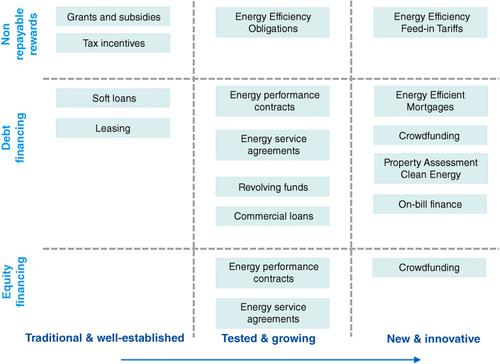当前位置:
X-MOL 学术
›
WIREs Energy Environ.
›
论文详情
Our official English website, www.x-mol.net, welcomes your feedback! (Note: you will need to create a separate account there.)
How to finance energy renovation of residential buildings: Review of current and emerging financing instruments in the EU
Wiley Interdisciplinary Reviews: Energy and Environment ( IF 6.1 ) Pub Date : 2020-06-21 , DOI: 10.1002/wene.384 Paolo Bertoldi 1 , Marina Economidou 1 , Valentina Palermo 1 , Benigna Boza‐Kiss 2, 3 , Valeria Todeschi 4
Wiley Interdisciplinary Reviews: Energy and Environment ( IF 6.1 ) Pub Date : 2020-06-21 , DOI: 10.1002/wene.384 Paolo Bertoldi 1 , Marina Economidou 1 , Valentina Palermo 1 , Benigna Boza‐Kiss 2, 3 , Valeria Todeschi 4
Affiliation

|
The Paris Agreement goals require net‐zero CO2 emissions by mid‐century. The European Commission in its recent proposal for climate and energy strategy for 2050 indicated the need for more intensified actions to substantially improve the energy performances of buildings. With the rate of new construction in Europe, the challenge is to increase both the pace and depth of building energy renovations. Several barriers inhibit the wide uptake of comprehensive energy renovations, including the inability or inertia to finance upfront costs of energy renovations. Despite various policies implemented to address some of these barriers, current investments in buildings remain at suboptimal levels. The paper reviews current financing practices for energy renovations and investigates some innovative instruments with a special focus on their applicability to residential buildings. In addition to “traditional” financial schemes such as subsidies, tax incentives, and loans, the paper assesses innovative financing schemes: On property tax and on‐bill financing, energy efficiency mortgages, and energy efficiency feed‐in tariffs. The paper also investigates the concept of one‐stop shops for building renovations and crowdfunding. The paper offers an assessment of the characteristics, benefits, and challenges of each analyzed financing instrument and provides policy recommendations for their successful implementation. In general, as financing instruments involve different stakeholders and due to complex nature of the sector, there is no single solution to accelerate energy renovation investment in buildings. The emerging financial models offer the potential to address the long‐standing barriers to investment in energy efficiency.
中文翻译:

如何为住宅建筑的能源改造提供资金:欧盟现行和新兴融资工具的回顾
《巴黎协定》目标要求净零二氧化碳2本世纪中叶的排放量。欧盟委员会在其最近的2050年气候和能源战略提案中指出,需要采取更多的措施来大幅改善建筑物的能源性能。随着欧洲新建筑的兴起,挑战在于增加建筑能源翻新的速度和深度。一些障碍阻碍了综合能源翻新的广泛采用,包括无法或惯性地为能源翻新的前期费用提供资金。尽管已采取各种政策来解决其中一些障碍,但目前对建筑物的投资仍处于次优水平。本文回顾了当前用于能源翻新的融资实践,并研究了一些创新工具,特别关注其在住宅建筑中的适用性。除了补贴,税收优惠和贷款等“传统”金融计划外,本文还评估了创新的融资计划:关于财产税和票据融资,能效抵押和能效上网电价。本文还研究了用于建筑翻新和众筹的一站式商店的概念。本文提供了对每种分析的金融工具的特征,收益和挑战的评估,并为成功实施这些金融工具提供了政策建议。通常,由于融资工具涉及不同的利益相关者,并且由于该行业的复杂性,因此没有单一的解决方案可以加快对建筑物的能源翻新投资。新兴的金融模型提供了解决长期存在的能源效率投资障碍的潜力。
更新日期:2020-06-21
中文翻译:

如何为住宅建筑的能源改造提供资金:欧盟现行和新兴融资工具的回顾
《巴黎协定》目标要求净零二氧化碳2本世纪中叶的排放量。欧盟委员会在其最近的2050年气候和能源战略提案中指出,需要采取更多的措施来大幅改善建筑物的能源性能。随着欧洲新建筑的兴起,挑战在于增加建筑能源翻新的速度和深度。一些障碍阻碍了综合能源翻新的广泛采用,包括无法或惯性地为能源翻新的前期费用提供资金。尽管已采取各种政策来解决其中一些障碍,但目前对建筑物的投资仍处于次优水平。本文回顾了当前用于能源翻新的融资实践,并研究了一些创新工具,特别关注其在住宅建筑中的适用性。除了补贴,税收优惠和贷款等“传统”金融计划外,本文还评估了创新的融资计划:关于财产税和票据融资,能效抵押和能效上网电价。本文还研究了用于建筑翻新和众筹的一站式商店的概念。本文提供了对每种分析的金融工具的特征,收益和挑战的评估,并为成功实施这些金融工具提供了政策建议。通常,由于融资工具涉及不同的利益相关者,并且由于该行业的复杂性,因此没有单一的解决方案可以加快对建筑物的能源翻新投资。新兴的金融模型提供了解决长期存在的能源效率投资障碍的潜力。



























 京公网安备 11010802027423号
京公网安备 11010802027423号